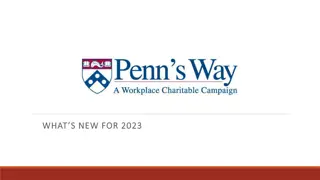Effective Performance Management: Setting Goals and Expectations at Penn State
Gain insights into the importance of performance management, learn goal-setting best practices, and understand the role and responsibilities of individuals in aligning goals at Penn State. Explore the ongoing process of setting expectations, assessing results, and fostering staff development through continuous conversations. Discover how everyone plays a crucial part in effective performance management, from employees owning the process to leaders championing it. Embrace guiding principles for successful performance management, emphasizing explicit expectations, engagement in planning work, and the value of regular feedback.
Download Presentation

Please find below an Image/Link to download the presentation.
The content on the website is provided AS IS for your information and personal use only. It may not be sold, licensed, or shared on other websites without obtaining consent from the author. Download presentation by click this link. If you encounter any issues during the download, it is possible that the publisher has removed the file from their server.
E N D
Presentation Transcript
Penn State Performance Management Penn State Performance Management Step One: Setting Goals and Expectations Step One: Setting Goals and Expectations Adobe Connect Seminar for Individual Contributors Adobe Connect Seminar for Individual Contributors Presenter: Stephanie Flanagan Presenter: Stephanie Flanagan slm114@psu.edu; 814-867-6436 Summer 2017
Todays session will help you to: Gain understanding of effective performance management and recognize its importance and benefits Identify your role and responsibilities related to performance management, starting with setting goals and expectations with your supervisor Learn the best practices for goal setting 2
Q: What is Performance Management? A: The process of setting expectations, aligning goals, assessing results, and focusing on staff development through ongoing conversations between managers and their direct report(s). Setting Expectations Goals and Objectives Goal Alignment Process of ensuring individual goals support the achievement of department goals and department goals support the achievement of University goals The process of discussing what is expected from an employee in terms of job roles and responsibilities Desired results each employee aims to achieve, determined based on conversations between managers and employees Assessment Performance Calibration Feedback and Development Process in which supervisors and managers at the same level in an organization discuss staff performance ratings and outcomes to ensure ratings and development messages are applied consistently across the University Review of goals, objectives, and other factors, and the determination of the level of successful achievement Focus of the conversations between managers and employees in determining strengths, opportunities for improvement, and how to grow and develop Performance management is not just a once-a-year conversation. It impacts staff over their entire career at Penn State. 3
Employee: I own the process. Effective Performance Management Involves Everyone! Supervisor: I partner in the process. Leader: I champion the process. Human Resources: I support the process. 4
Guiding Principles for Effective Performance Management Should be an ongoing process of setting expectations, executing plans and evaluating results. Expectations should be explicit and mutually understood. Engagement is increased when people are involved in planning the work. How work gets accomplished is as important as what gets accomplished. Regular, honest feedback increases understanding and positive performance. 5
YOU@PSU Performance Management Cycle: April 1, 2017- March 31, 2018 (End-of-Year Activities: April & May 2018) STEP ONE: STEP TWO: Mid-Year Check-In (Use PDF Conversation Tracker) STEP THREE: End-of-Year Review (Use Workday) Setting Goals & Expectations (Use PDF Goal Setting Worksheet) Ongoing Conversations between staff members and their supervisors throughout the year; Goal setting document available to track progress and record conversation highlights Review goals and progress (make adjustments as needed) PREPARATION: Staff member meets with supervisor to discuss expectations and set 2-5 goals for the 2017-18 performance management cycle Staff member completes self-evaluation in Workday Check-in re: expectations and acknowledgement of successes and challenges Optional: staff member and supervisor obtain feedback from others (e.g., peers, customers, etc.) Staff member captures the agreed upon goals in the goal setting worksheet Supervisor reviews and summarizes performance feedback for staff member in Workday Staff member reviews Job Responsibility Worksheet in online tool (and updates, if applicable); supervisor reviews and approves in online tool Peer supervisors conduct ratings calibration meetings (two levels) DELIVERY: LEADERS Staff member meets with supervisor to discuss end-of-year review and receive an overall rating of their performance; acknowledgement of meeting occurs in Workday HR Strategic Partners provide leadership teams performance results from the previous year Leadership teams meet to discuss ratings and agree on norms; norms are shared with staff members during the goal setting process Staff member and supervisor begin to discuss next year s goals and development opportunities Recommended Timing: June 1 August 31, 2017 Recommended Timing: November 1- December 31, 2017 Recommended Timing: April 1- May 15, 2018 6
Program Components CONTENT AREA EXAMPLES FOCUS 1. Job Assist department head in administration of department procedures and programs What are the most critical tasks and activities I am responsible for day-to-day? Responsibilities What is Done 2. Annual Goals Transition all budget records from old to new tracking system by March 31, 2018 What do we need to accomplish this year in order to support my department s goals? What is Done Communication: Fosters open dialogue and actively listens to others in order to build and maintain effective and respectful working relationships throughout the university 3. Competencies & Behaviors What specific competencies and behaviors will help me accomplish my job responsibilities and achieve my goals for this year? How it is done I have read and understand the PSU Values and my obligations under AD88: Code of Responsible Conduct. AND 4. Values & Compliance Completion of Reporting Child Abuse Training; Clery Act Training; Safety Training, etc. How it is done I understand my compliance obligations and have completed the associate required compliance training(s) for my position. 7
Ratings Scale The three-rating scale is simple to communicate and allows for honest communication of employee effectiveness while maintaining flexibility to differentiate performance Performance is based around expectation; therefore, these ratings can be applied to individuals with any length of service at Penn State PERFORMANCE RATINGS FOR INDIVIDUAL COMPONENTS Description Rating Illustrative Example Successful Demonstrates the appropriate level of knowledge and/or skills. Performs effectively and consistently. Achieves goal targets Sets goal to cut department expenses by 10%, cuts by 8-12% Exceptional Demonstrates and applies exceptional level of knowledge and skills. Consistently excels. Significant achievement relative to goals Sets goal to cut department expenses by 10%, cuts by over 12% Needs Improvement Demonstrates a lack of knowledge and/or skills. Does not perform consistently. Does not achieve goals Sets goal to cut department expenses by 10%, cuts by less than 8% PERFORMANCE RATINGS FOR OVERALL COMPONENTS Description Rating Illustrative Example Successful Contributor Consistently proficient in individual evaluation components; may be strong in several areas. Meets goals and job requirements; consistently demonstrates competencies & behaviors Viewed as Successful on most goals, job responsibilities, competencies & behaviors; may be Exceptional in several areas; may receive a few Needs Improvement ratings on individual goals/behaviors Exceptional Contributor Consistently strong in the majority, if not all, individual evaluation components. Exceeds goals and job requirements; goes above and beyond to demonstrate behaviors Viewed as Exceptional on almost, if not all, goals, behaviors, and job responsibilities; Successful in remaining program components Needs Improvement Needs improvement in most individual evaluation components. Does not meet goals and fails to satisfy job requirements; does not demonstrate competencies & behaviors Receives a Needs Improvement on a majority of goals, job responsibilities, competencies & behaviors; may be Successful in a few areas 8
Setting Goals and Expectations: A Collaboration Your Role as Individual Contributor Your Supervisor s Role 1. Clearly communicate expectations re: your job responsibilities and competencies (skills) and behaviors 1. Understand your role and how it supports the work of your department; participate actively in setting expectations 2. Communicate how your individual goals align with department and organization goals 2. Work with your supervisor to set clear, measurable performance goals 3. Help you set clear, measurable performance goals 3. Monitor your own performance compared to expectations 4. Offer advice and guidance regarding your performance on a consistent, on-going basis 4. Seek advice and guidance as needed from your supervisor 9
Setting Goals and Expectations Discuss and Document Job Responsibilities Discuss your role and job responsibilities with your supervisor and work together to ensure that your JRW is accurate. a. Starts with a conversation around your Job Responsibilities Worksheet (JRW), a useful tool for managing performance; serves as an negotiated agreement between you and your supervisor. The JRW includes: Summary of the position Key job responsibilities Required competencies: Communication, Effective Knowledge, Teamwork/Leadership, Problem-Solving& Innovation, and Accountability/Self- Management Supervisory responsibility (if applicable) Unit peers (if applicable) 10
Setting Goals and Expectations Discuss Expectations Discuss any expectations your supervisor may have regarding HOW you get your work done. b. Job Responsibility Job Responsibility Manage supply inventory for upcoming on- and off-campus events Expectation Expectation Maintain methodology/process for tracking available inventory Inform appropriate staff when supplies are running low in order to replenish supplies before they are needed Monitor supply delivery to ensure timely ordering and receipt of supplies for events Ensure data contained in reports is 100% accurate Deliver reports to the group no later than 2 weeks after each quarter ends Update supervisor bi-weekly on expense activity versus budget Alert staff when their expenses are close to the budget levels Compile event status reports for the group on a quarterly basis Monitor expenditures against events budget 11
Setting Goals and Expectations Review University and department goals Discuss how your role and strengths can support the University and ensure goal alignment Institutional Strategy and Goals Mission, Strategy, and Goals Open and Clear Communication of Institutional Strategic Plan and its Impact on Colleges/Units/Departments College, Unit, and Department Strategies and Goals College/Unit/Department Plans and Goals in Support of Institution Goals Open and Clear Communication of College/Unit/Departmental Strategic Plan and its Impact on Teams and Individuals Individual and Team Goals Individual and Team Goals Individual and Team Goals Annual goals linked to College/Unit/Department goals clearly articulate: 1. What to achieve this year and 2. How success will be measured 12
Setting Goals and Expectations Draft individual goals: Work with your supervisor to identify 2-5 goals for you to work towards achieving in the upcoming year/cycle. At least one goal should support department/unit goals and one goal should support ongoing job responsibilities/professional development. If you are a supervisor, a goal should be set that directly links to that part of your role. Goals may be accomplished over several years. Document the following for each goal: Goal description: Be sure it is SMART! Action steps to achieve goal: The specific actions or steps you will need to take to reach your goal Metrics/definition of success: The measurement you will use to determine whether or not you achieved your goal Resources needed: Resources you may need in order to achieve this goal-- such as time (your time, your supervisor's, your colleague's), money, materials, etc. Target Date: The specific deadline for when you expect to achieve this goal. Be realistic. The goal span over more than one performance management cycle. 13
Setting Goals and Expectations Example Example A good start A good start A SMART finish! A SMART finish! If the focus is to reduce If the focus is to reduce department expenses department expenses Lower department expenses. Reduce department expenses by 1-2% by March 31, 2018 by following the new departmental purchasing procedures. If the focus is on an IT If the focus is on an IT project project Complete new system implementation. Complete and implement the new ERP system by February 1, 2018 through effective collaboration across IT functions and cross-functional teams. Strive for SMART goals! 14
Avoid Common Pitfalls Pitfall: Pitfall: Too many goals Limit the number of annual goals to 2 5 to ensure focus on the most important results Pitfall: Unclear accountability Clarify who is accountable for achieving the goal especially important in teams or where work is highly interrelated Pitfall: Unclear expected results or measures Clearly describe the qualities or measures of the expected results to reduce ambiguity 15
WII-FM? Effective Performance Management Helps Us to: Target critical talent for development and retention Execute strategy by prioritizing and aligning goals and objectives Improve performance of groups and individuals Make better pay decisions based on performance and desired results Identify top performers to develop a succession plan 16
Step One: Setting Goals and Expectations Immediate Next Steps 1. Meet with your supervisor to review your Job Responsibilities Worksheet (JRW) and to identify 2-5 goals that you will work towards achieving by March 31, 2018. 2. After your meeting, update your JRW into the JRW online tool and submit it for your supervisor s approval. Complete your Goal Setting Worksheet (pdf) and share with your supervisor. 3. Goals will be reviewed formally during the Mid-Year Check In and then will be rated as part of the End-of-Year Review. Use the Performance Management Conversation Tracker (pdf) on a regular basis to record the on-going conversations you are having with your supervisor around your progress towards goal achievement, professional development and examples of strong performance and/or challenges. 17























